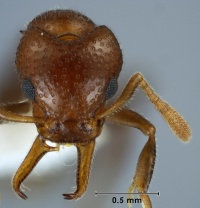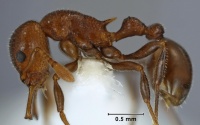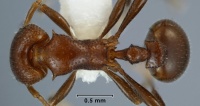Epopostruma monstrosa
| Epopostruma monstrosa | |
|---|---|

| |
| Scientific classification | |
| Kingdom: | Animalia |
| Phylum: | Arthropoda |
| Class: | Insecta |
| Order: | Hymenoptera |
| Family: | Formicidae |
| Subfamily: | Myrmicinae |
| Tribe: | Attini |
| Genus: | Epopostruma |
| Species: | E. monstrosa |
| Binomial name | |
| Epopostruma monstrosa Viehmeyer, 1925 | |
Nests and foragers of E. monstrosa have been found under a stone near the base of a Eucalyptus, in leaf litter, under a rock in an area dominated by Papyrius nitidus, foraging on the trunk of scribbly gum 4 feet off the ground at 6pm, under a tree near a large colony of Notoncus gilberti and in a bare patch of soil. Habitats where it has been found include heath on sandy soil, a swamp, open sclerophyll, dry sclerophyll, medium sclerophyll, flats, coastal scrub and paperbark scrub. It is currently known from four widely separate areas: northern Queensland, south-eastern Queensland, south-coastal New South Wales and the Melbourne area of Victoria.
Identification
The shape of the postpetiole, with its relatively long and flat anterior face compared to the dorsal face, will separate this species from others in the quadrispinosa species group. It should be noted that the northern-most collections of this species differ from their southern counterparts in having slightly more distinct large foveae on the petiole and postpetiole. This difference is interpreted as intraspecific geographic variation due to the large distance (over 1300 km) between these collection localities rather than evidence that separate species are involved.
Keys including this Species
Distribution
Latitudinal Distribution Pattern
Latitudinal Range: -16.48332977° to -37.66667°.
| North Temperate |
North Subtropical |
Tropical | South Subtropical |
South Temperate |
- Source: AntMaps
Distribution based on Regional Taxon Lists
Australasian Region: Australia (type locality).
Distribution based on AntMaps
Distribution based on AntWeb specimens
Check data from AntWeb
Countries Occupied
| Number of countries occupied by this species based on AntWiki Regional Taxon Lists. In general, fewer countries occupied indicates a narrower range, while more countries indicates a more widespread species. |

|
Estimated Abundance
| Relative abundance based on number of AntMaps records per species (this species within the purple bar). Fewer records (to the left) indicates a less abundant/encountered species while more records (to the right) indicates more abundant/encountered species. |

|
Biology
Castes
Nomenclature
The following information is derived from Barry Bolton's Online Catalogue of the Ants of the World.
- monstrosa. Epopostruma monstrosa Viehmeyer, 1925a: 30 (q.) AUSTRALIA. Combination in Mesostruma: Brown, 1952g: 13; in Epopostruma: Taylor, 1973: 25. See also: Taylor, 1991b: 602; Shattuck, in Bolton, 2000: 64.
Type Material
- Holotype, queen or gynandromorph (specimen fragmentary), Trial Bay, New South Wales, Australia, Berlin Museum für Naturkunde der Humboldt-Universität.
Unless otherwise noted the text for the remainder of this section is reported from the publication that includes the original description.
Epopostruma monstrosa was established by Viehmeyer (1925) for a single queen from north coastal New South Wales. Taylor (1991) provides notes on this specimen and associated it with workers, thus allowing this species to be compared with the remaining species of the genus, all of which are worker-based. Earlier, Brown (1948:119) had transferred this species to Mesostruma, a move later reversed by Taylor (1973), who transferred it back to Epopostruma.
Description
Shattuck (2000) - In full face view the lateral margin of the head between the eye and the posterior corner a gentle convexity. Pronotal spines distinct. Posterior section of metanotum in approximately the same plane as the dorsal face of propodeum, the junction between these plates a weak, indistinct concavity. Posterior face of propodeum between bases of spines and propodeal lobes with thin flanges. Petiolar spines present, short and thin. Anterior face of postpetiole flat, longer than dorsal face; sides approximately vertical, rounding gradually from dorsal to posterior surfaces and with sharp angles at the anterior and posterior corners, the posterior corners slightly longer and wider than the more rounded anterior angles. Dorsum of petiole, postpetiole and gaster numerous very short erect hairs. First gastral tergite smooth or nearly so, at most with only very weak, indistinct sculpturing; area immediately behind attachment with gaster with short longitudinal rugae. Body colour varying from yellow-red to red-brown; gaster uniform red-brown.
Measurements
Worker (n=6): TL 3.3-4.4mm, HL 0.78-0.98mm, HW 0.66-0.88mm, CI 84-93, MandL 0.40-0.48mm, MandI 44 -51, SL 0.46-0.56mm, SI 61-74, PronW 0.44-0.59mm, ML 0.89-1.14mm.
References
- Bolton, B. 2000. The ant tribe Dacetini. Mem. Am. Entomol. Inst. 65: 1-1028 (page 64, redescription of worker)
- Brown, W. L., Jr. 1952j. The dacetine ant genus Mesostruma Brown. Trans. R. Soc. S. Aust. 75: 9-13 (page 13, Combination in Mesostruma)
- Heterick, B.E. 2021. A guide to the ants of Western Australia. Part I: Systematics. Records of the Western Australian Museum, Supplement 86, 1-245 (doi:10.18195/issn.0313-122x.86.2021.001-245).
- Heterick, B.E. 2022. A guide to the ants of Western Australia. Part II: Distribution and biology. Records of the Western Australian Museum, supplement 86: 247-510 (doi:10.18195/issn.0313-122x.86.2022.247-510).
- Shattuck, S. O. 2000. Genus Colobostruma. Genus Mesostruma. Genus Epopostruma. Pp. 31-67 in: Bolton, B. The ant tribe Dacetini. Mem. Am. Entomol. Inst. 65: 1-1028 (page 63, worker, queen described)*Taylor, R. W. 1973. Ants of the Australian genus Mesostruma Brown (Hymenoptera: Formicidae). J. Aust. Entomol. Soc. 12: 24-38 (page 25, Combination in Epopostruma)
- Taylor, R. W. 1991b. Nomenclature and distribution of some Australasian ants of the Myrmicinae (Hymenoptera: Formicidae). Mem. Qld. Mus. 30: 599-614 (page 602, taxonomic status)
- Viehmeyer, H. 1925a. Formiciden der australischen Faunenregion. (Fortsetzung.). Entomol. Mitt. 14: 25-39 (page 30, queen described)
References based on Global Ant Biodiversity Informatics
- Taylor R. W. 1973. Ants of the Australian genus Mesostruma Brown (Hymenoptera: Formicidae). Journal of the Australian Entomological Society 12: 24-38.
- Taylor R. W. 1987. A checklist of the ants of Australia, New Caledonia and New Zealand (Hymenoptera: Formicidae). CSIRO (Commonwealth Scientific and Industrial Research Organization) Division of Entomology Report 41: 1-92.
- Taylor R. W. 1991. Nomenclature and distribution of some Australasian ants of the Myrmicinae (Hymenoptera: Formicidae). Memoirs of the Queensland Museum 30: 599-614.

